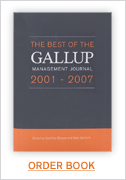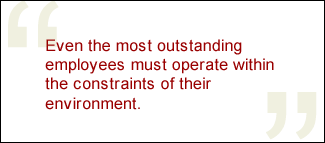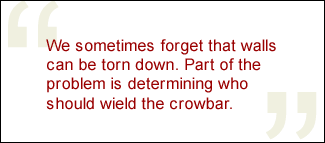After a long, hard journey, a traveler finally arrives at his hotel. It's late, and he's exhausted. When he gets to the front desk, he discovers that the hotel is overbooked. He no longer has a room. The clerk behind the desk shrugs and tells him, "There's nothing I can do."
 |
This is a true story. It may sound painfully familiar to anyone who has experienced maddening frustration with an employee who is supposed to be delivering customer service.
Here are two more stories -- also true. They are different scenarios, but, as we will discuss, the root of the problem is essentially the same:
- An escrow agent calls a mortgage service center with a serious problem. They have a closing that afternoon, she says, and have not yet received the closing statement, though it had been requested several days before. The service representative says that the agent's request is in the queue but isn't ready, and he has no idea when it will be done. The agent requests a verbal payoff but is told that the company does not provide them. She asks to speak with a supervisor and is refused. The call ends with the agent, clearly upset, hoping that none of her customers ever use that mortgage company again.
- In a call center, a customer service representative (CSR) needs to transfer a customer to another department. Because it's a holiday, that department is closed. The CSR, knowing that the department is closed, asks the customer to call the next day and gives him the direct number. The CSR was penalized on her quality evaluation for not "trying to transfer the call" even though she knew no one would answer.
What do these stories have in common? In each case, the employee had little leeway to make things right for the customer. Because of the circumstances, rules, policies, practices, and structure of their organizations, these workers were either compelled to do the wrong thing, or, in the case of the CSR, punished for doing the right thing.
 |
Those rules and policies may have been put in place with the best of intentions, but the results were damaging to the customers who were forced to endure negative experiences and to the employees who were forced to inflict them. The results were also bad for business because they destroyed a significant amount of the emotional connection between the company and its customers and employees. And those connections -- what Gallup calls employee and customer engagement -- are vital for business because they're what drive organic growth.
Barriers to engagement, such as the arbitrary rules in the previous scenarios, do more than turn customers away. They can force workers to "work around" the system to provide good customer service or frustrate employees and drive them away. Worst of all, in almost every case, these barriers are both unnecessary and self-imposed.
Ultimately, despite other substantial efforts companies may be making to build engagement, barriers like these prevent them from engaging their customers and employees. This two-part series explores the nature of those barriers -- and shows how companies can overcome them.
Hitting a wall
U.S. businesses have spent millions of dollars measuring and managing employee and customer engagement -- or the related topics of employee and customer satisfaction -- often using methods that are tactical and reactive. Even when organizations take a holistic and proactive approach, the focus is sometimes limited to a local level: Individual managers and teams receive the data and coaching tools they need to drive improvement in their divisions or workgroups but not the support to overcome institutional barriers.
When that happens, organizations that are measuring engagement may well see a "flattening" of employee engagement scores. Workgroups can do a great deal to improve employee engagement at the local level; one of the most effective tactics is to conduct impact planning sessions. (See "You've Gotten Employee Feedback. Now What?" and "What to Do With Employee Survey Results" in the "See Also" area on this page.) Once teams maximize the gains from this kind of problem solving, however, often what remains are the stubborn, painful barriers that prevent teams from achieving their optimum engagement and productivity.
Removing these barriers is often outside the direct control or influence of a workgroup or its supervisor. For example, although efforts have been made to increase communication effectiveness at a call center, CSRs are still being held accountable for company-wide policy changes they have not heard about. Or a supervisor wholeheartedly supports a new emphasis on training but finds she still doesn't have time to coach and develop her employees.
Ultimately, problems like these cannot be solved by an individual or a workgroup. Unless organizations take responsibility for removing these kinds of institutional barriers, managers and teams will spend a tremendous amount of time and energy dealing with the same problems over and over in their impact planning sessions. To drive sustained improvement in employee and customer engagement -- and ultimately, organic growth -- companies need a way to systematically identify and address barriers that exist throughout the company.
 |
To help organizations overcome these challenges, Gallup conducted a year-long study of barriers to employee and customer engagement across organizations in the automotive, financial services, public utilities, high tech, manufacturing, insurance, mass merchandising, and government industries. The work spanned several countries, including Australia, India, Mexico, Poland, Thailand, the United Kingdom, and the United States. The study included an in-depth examination of organizations' current policies, practices, and procedures; a review of current initiatives; and interviews or focus groups with top management, middle management, frontline supervisors, frontline employees, and support staff.
The study uncovered about 200 barriers to employee and customer engagement. Even though the industries, countries, and companies were different, those barriers shared several characteristics.
Barriers are outside local control
As noted above, substantial improvements in employee and customer engagement can be achieved by talented employees who are well-managed by capable supervisors and leaders. But even the most outstanding employees must operate within the constraints of their environment. As hard as they try, at some point, these managers and workgroups won't be able to improve engagement when they encounter barriers they don't have the authority to remove.
Barriers are typically imposed by employees who are far away from the front lines. Sometimes barriers are created by workers within the same department, but often they emanate from outside departments, such as marketing, human resources, or the legal team. They could be the result of rules or policies, new programs, resource allocation decisions, or other corporate initiatives.
Whatever the case, the most profound barriers are iron-clad rules and practices that must be obeyed without fail. Supervisors and employees ignore them at their own risk.
Barriers are damaging to employees and customers
Obviously, not all rules are bad. A company must have policies and procedures to avoid unnecessary risk, ensure efficiency, and provide consistent service. As such, these rules aren't necessarily barriers. Some barriers may be the result of other factors, such as infrastructure or resource allocation decisions.
The difference between a barrier and something constructive is that barriers prevent:
- employees from using common sense
- customers from getting the answers they need
- efficiency
- a holistic view of the customer relationship
- the creation of a positive and engaging workplace
- the organization from reacting quickly
Most of all, barriers ultimately prevent financial success.
Amazingly, our research indicates that most employees -- at all levels -- know that these practices are harmful. Employees often comment, "We are treated like children," "What we do makes no sense," or "No one trusts us." And the damage multiplies.
Barriers put the emphasis on control
No one adds words to customer service scripts just to make customers angry. Including the phrase "Is there anything else I can help you with?" at the end of a call seems to be absolutely the right thing to say.
 |
But what if the CSR could not solve the customer's problem? Or what if the customer just said he was in a hurry and needed to hang up? Under those circumstances, saying "Is there anything else I can help you with?" can actually make customers angry, though it seems like an easy way to appear focused on the customer.
Companies rarely create engagement barriers on the first day they open their doors. As companies grow, though, "control" becomes more difficult, yet it seems more attractive. If an employee makes 10 decisions every hour, a company with 100,000 employees will have 8 million decisions made by those employees every day.
That can be a frightening thought for executives. One manager of a large pharmaceutical support company said, "We have nearly ten thousand frontline employees. That's too many to control. We can't allow them to say whatever they want."
The key to overcoming this fear is to view the situation differently. Although the company has 10,000 frontline employees, it really has about 850 teams, each with 10-12 customer service representatives. There are about 80 departments that each manage about 10-11 teams. So, no one person needs to worry about more than what 12 people, at most, are doing at any one time. Viewing the company this way makes the idea of "empowerment" a lot less scary.
Barriers can be removed
One professional services executive said, "One of the worst and best things I ever did was buy a crowbar. Now I come home, and my wife, who loves redecorating, will -- without warning -- have started ripping something apart. At first, it drove me crazy, but as we got into each project, I could see that the original wood underneath was rotting or that the current setup just was not working. And once she explained her vision, I could see how much better it would be when the project was done. I have learned that the same thing is true in businesses. Impossibility often exists only in someone's mind as a defense mechanism. Addressing problems requires work, but in the end, it's worth it."
We sometimes forget that walls can be torn down. Part of the problem is determining who should wield the crowbar and how they should be allowed to use it. For example, one executive of a retail organization said, "Our store managers each get more than one hundred reports a month. But the good managers know which three or four they should look at."
In this case, the solution seems obvious: Stop doing the other 96 reports. The problem, however, is that it's unclear why those reports originated, how they are being used, why they are considered important, or who "owns" them.
In Part 2 of this article, we'll explore the root causes of barriers like these and what companies can do to overcome them.